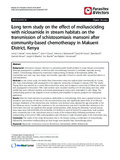Long term study on the effect of mollusciciding with niclosamide in stream habitats on the transmission of schistosomiasis mansoni after community-based chemotherapy in Makueni District, Kenya

View/
Date
2014Author
Kariuki, Henry C
Madsen, Henry
Ouma, John H
Butterworth, Anthony E
Dunne, David W
Booth, Mark
Kimani, Gachuhi
Mwatha, Joseph K
Muchiri, Eric
Vennervald, Birgitte J
Metadata
Show full item recordAbstract
Schistosoma mansoni infection is a persistent public health problem in many Kenyan communities. Although praziquantel is available, re-infection after chemotherapy treatment is inevitable, especially among children. Chemotherapy followed by intermittent mollusciciding of habitats of Biomphalaria pfeifferi, the intermediate host snail, may have longer term benefits, especially if timed to coincide with natural fluctuations in snail populations.In this cohort study, the Kambu River (Intervention area) was molluscicided intermittently for 4 years, after mass chemotherapy with praziquantel in the adjacent community of Darajani in January 1997. The nearby Thange River was selected as a control (Non-intervention area), and its adjacent community of Ulilinzi was treated with praziquantel in December 1996. Snail numbers were recorded monthly at 9–10 sites along each river, while rainfall data were collected monthly, and annual parasitological surveys were undertaken in each village. The mollusciciding protocol was adapted to local conditions, and simplified to improve prospects for widespread application.After the initial reduction in prevalence attributable to chemotherapy, there was a gradual increase in the prevalence and intensity of infection in the non-intervention area, and significantly lower levels of re-infection
amongst inhabitants of the intervention area. Incidence ratio between areas adjusted for age and gender at the first follow-up survey, 5 weeks after treatment in the non-intervention area and 4 months after treatment in the intervention area was not significant (few people turned positive), while during the following 4 annual surveys these ratios were 0.58 (0.39-0.85), 0.33 (0.18-0.60), 0.14 (0.09-0.21) and 0.45 (0.26-0.75), respectively. Snail numbers were consistently low in the intervention area as a result of the mollusciciding. Following termination of the mollusciciding at the end of 2000, snail populations and infections in snails increased again in the intervention area.The results of this study demonstrate that in the Kenyan setting a combination of chemotherapy followed by intermittent mollusciciding can have longer term benefits than chemotherapy alone.
